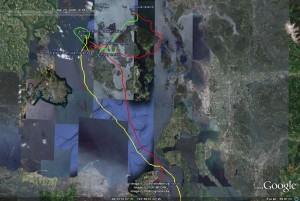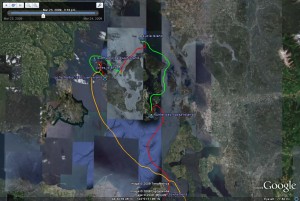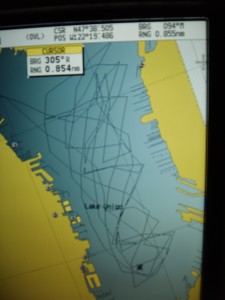A Fleming mechanical self-steering wind vane came with Apropos and has been kept in my garage the past 4 years. It’s an older model built in the 1980’s, but appears to be in great shape. The system is a bulky stainless steel mechanical marvel that weighs a ton. It attaches to the stern with 4 struts and its purpose is to steer the boat in a desired direction using only the wind. It has a wind vane, a small rudder attached to a pendulum, and a drum that connects to the wheel. Once the boat is heading in a desired direction with respect to the wind, the pendulum will make adjustments to the wheel whenever the heading (with respect to the wind) changes. A linkage (two 6 mil nylon lines) goes from the pendulum to a wheel adapter, which is a drum fastened to the wheel. The drum is wrapped 3-4 times with 8 mil nylon rope that has eyes on both ends. These systems are very helpful for offshore cruising so you don’t have to sit behind the wheel hand steering all the time. I recently took the system apart and freed the toothed adjusting disc that had seized from years of sitting around. It took lots of WD-40 solvent and some time before it finally turned easily. The only piece I believe is missing is the drum that connects onto the wheel. Tonight I finally got thru to Fleming (based in Australia) and ordered a new stainless steel wheel adapter and a storm vane (a smaller wind vane used when the wind is really blowing). Both will be shipped to Sydney since we’re going there in a few weeks. They were $643 AUS including shipping. I plan on hooking it up to Apropos this summer and trying it out during our trip to the Gulf Islands in August.
Monthly Archives: March 2009
Google Map of 2008 Gulf Islands trip
Google Map of 2006 San Juan Islands trip
Google Map of 2007 San Juan Islands trip
gps tracking on lake union
Puget Sound Cruising Club (PSCC)
We joined the Puget Sound Cruising Club last month! They are a fun group of cruisers who get together for monthly meetings throughout the year. They also have an anual dinner/auction that we have been going to for a few years as guests. We’re looking forward to the raftups and getting to know the other members.
LED lighting
Apropos has 10 overhead dome lights and 6 floor-level courtesy lights that use incadescent bulbs. Each bulb is 10W which means each light draws about 1A of current. Replacing the bulb with LED lighting would reduce the current draw by 1/10th. It is important when cruising to keep the amp-hours to a minimum, and the conversion to LED would help.
One solution is to use HBLEDs (high-brightness LEDs). A drive circuit is needed to source the proper current through a string of HBLEDs. I want to use a PSoC chip since I’ve spent the past 10 years helping to design it at Cypress Semiconductor. It’s a reconfigurable 8-bit micro-controller that can be configured for LED driving. The driver would consist of a PWM (pulse width modulator) NFET gate drive. Setting the PWM would control the brightness of the LEDs. External components would be the NFET, an inductor, a flyback diode, a capacitor, and a voltage regulator. These could be placed on a small board along with the 4-5 HBLEDs and the PSoC chip. An option would be to have 5 red LEDs and 5 white LEDs and a switch to select either red (for night-time cruising where you want to retain night vision when going below deck) or white. One PSoC chip could drive both circuits.



